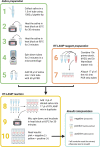Initial Evaluation of a Mobile SARS-CoV-2 RT-LAMP Testing Strategy
- PMID: 35035293
- PMCID: PMC8730517
- DOI: 10.7171/jbt.21-32-03-009
Initial Evaluation of a Mobile SARS-CoV-2 RT-LAMP Testing Strategy
Abstract
Severe acute respiratory syndrome coronavirus 2 (SARS-CoV-2) control in the United States remains hampered, in part, by testing limitations. We evaluated a simple, outdoor, mobile, colorimetric reverse-transcription loop-mediated isothermal amplification (RT-LAMP) assay workflow where self-collected saliva is tested for SARS-CoV-2 RNA. From July 16, 2020, to November 19, 2020, surveillance samples (n = 4704) were collected from volunteers and tested for SARS-CoV-2 at 5 sites. Twenty-one samples tested positive for SARS-CoV-2 by RT-LAMP; 12 were confirmed positive by subsequent quantitative reverse-transcription polymerase chain reaction (qRT-PCR) testing, whereas 8 tested negative for SARS-CoV-2 RNA, and 1 could not be confirmed because the donor did not consent to further molecular testing. We estimated the false-negative rate of the RT-LAMP assay only from July 16, 2020, to September 17, 2020 by pooling residual heat-inactivated saliva that was unambiguously negative by RT-LAMP into groups of 6 or fewer and testing for SARS-CoV-2 RNA by qRT-PCR. We observed a 98.8% concordance between the RT-LAMP and qRT-PCR assays, with only 5 of 421 RT-LAMP-negative pools (2493 total samples) testing positive in the more-sensitive qRT-PCR assay. Overall, we demonstrate a rapid testing method that can be implemented outside the traditional laboratory setting by individuals with basic molecular biology skills and that can effectively identify asymptomatic individuals who would not typically meet the criteria for symptom-based testing modalities.
Keywords: colorimetric LAMP; point-of-care test; saliva-based.
© 2021 ABRF.
Conflict of interest statement
Conflicts of interest C.M.N., D.M.D, and A.M.W provided consulting services to Salus Discovery LLC.
Figures



Update of
-
Initial evaluation of a mobile SARS-CoV-2 RT-LAMP testing strategy.medRxiv [Preprint]. 2021 Feb 27:2020.07.28.20164038. doi: 10.1101/2020.07.28.20164038. medRxiv. 2021. Update in: J Biomol Tech. 2021 Sep;32(3):137-147. doi: 10.7171/jbt.21-32-03-009. PMID: 33655260 Free PMC article. Updated. Preprint.
References
-
- Havers FP, Reed C, Lim T, et al. Seroprevalence of antibodies to SARS-CoV-2 in 10 sites in the United States, March 23–May 12, 2020. JAMA Intern Med. 2020;180:1576–1586. - PubMed
Publication types
MeSH terms
Substances
Supplementary concepts
Grants and funding
LinkOut - more resources
Full Text Sources
Medical
Miscellaneous
